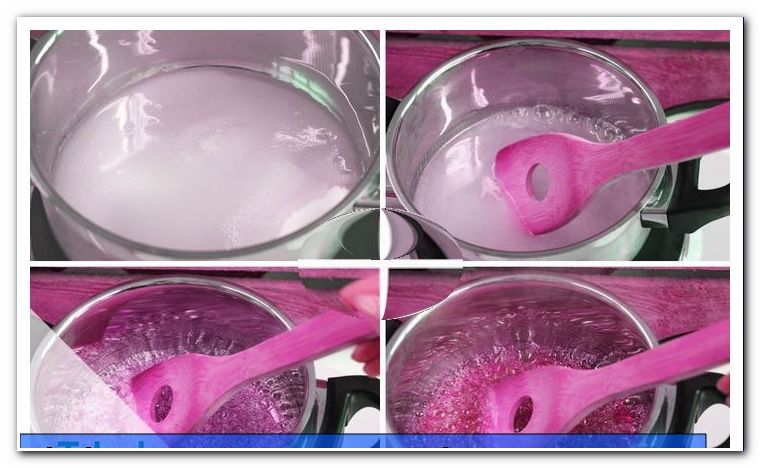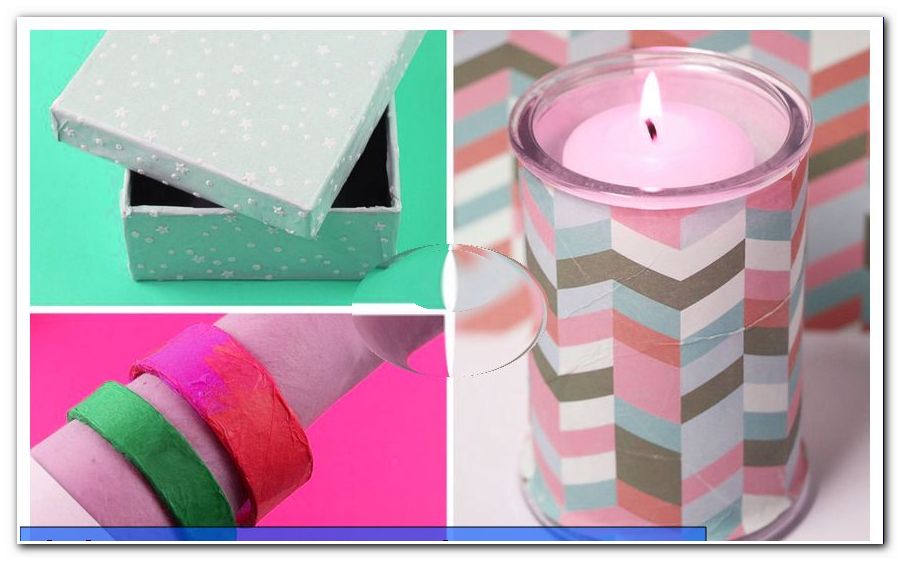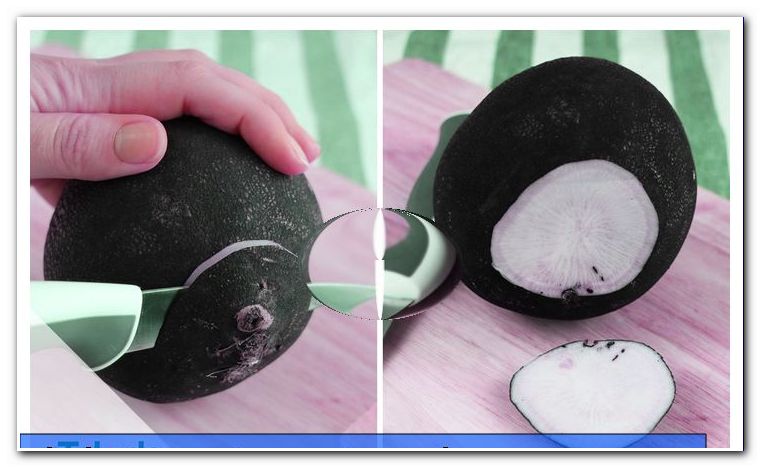Crochet vegetables - Instructions for carrots, peppers and Co.

- Crochet vegetables
- Material and preparation
- Previous knowledge
- Remove stitches
- Crochet carrot
- Crochet eggplant
- Crochet the peppers
- Crochet radishes
- Crochet tomato
Crochet vegetables, which is like crocheting fruit or crocheting cactus, to the Amigurumi works, which should not be missing in any kitchen as a decoration. It is friendly and homey, always fresh vegetables, such as crocheted carrots, peppers, eggplants, radishes and tomatoes.
We'll show you how easy it is to crochet any vegetable. Our instructions are again written very simply, so that even beginners can find joy in crocheting vegetables.
Crochet vegetables
If you look at our vegetables and read through the instructions, you will soon realize that the crochet work is very similar. Whether long or round vegetables, edgy or smooth, the basic technique is always the same. So you do not have to be a big crochet master to do our vegetables.
In a kitchen, the individual vegetables naturally look very decorative. You can also crochet the pepper, the carrot, the tomato or the radish but also for the shop. The small buyers and sellers are guaranteed to be able to play with such real-looking vegetables. Especially for small children's hands, this soft and even crocheted vegetables is a wonderful toy.
In our vegetable basket are very different types of vegetables. We chose paprika, carrots, tomatoes, garlic, corn, aubergine and radishes. You determine the size of the individual parts by your yarn and your own needle size. The thicker the wool and the needle, the bigger the vegetables become. But if you want to crochet a small and delicate vegetable, then you should process a thin cotton yarn with a small needle size.

Material and preparation
As with all crochet work is also here: is allowed, what pleases. For which yarn you choose, that is of course up to you. Amigurumi works, however, always look very nice with cotton yarn. This is because the cotton makes the stitch pattern very clear and clear. This gives the crochet work its special character.
We decided on a mixed cotton yarn. Our yarn thickness corresponds to the needle sizes 2.5 mm and 3 mm . You can easily increase or decrease the size of the vegetables using yarn and needle size, without having to make any changes to the number of stitches in our manual.
As filling material we used a synthetic filling wool. But you can also use pure sheep wool.
According to our instructions you need:
- Cotton yarn in different colors
- Füllwolle
- Crochet hooks suitable for yarn thickness
- Needle for sewing the crochet work

Previous knowledge
The vegetables are crocheted with:
- strong stitches
- Half sticks
- rod
- chain stitches
- stitches
- thread ring
Tip: If you are a little bit unsure about a scam, then take a look at our "Learn Crochet" section. There you will find all listed stitches simply explained. Also the thread ring.
Remove stitches
In the individual instructions, for example, we wrote: Take off 1 stitch.
This decrease goes like this:
Cut into the first stitch, pick up the work thread and place it on the needle, cut in the following stitch, get the working thread, pull the thread through all three loops on the needle.
Crochet carrot

For the carrots or carrots we chose orange colored cotton yarn with a crochet hook of size 3 . The carrot is worked from the lower tip to the top.
- Create a thread ring
- 3 solid stitches in the thread ring work
1st round: double every stitch = 6 stitches.
2nd round: crochet 1 stitch = 6 stitches in each stitch.
3rd round: double every 2nd stitch = 9 stitches.
Sew on the initial thread and turn the work to the right side.
Tip: Put a mesh counter in each round.
It is enough if you use a short different colored yarn for this purpose.
4th round: Work in each stitch 1 tight stitch.
5th round: double every 3rd stitch = 12 stitches.
Round 6: Crochet 1 stich in each stitch = 12 stitches.
Round 7: Double every 4th stitch = 15 stitches.
8th and 9th round: Crochet 1 stitch in each stitch.
Round 10: Double every 5th stitch = 18 stitches.
Round 11 - Round 26: All rounds are crocheted without any increase. In each stitch work a tight stitch.
Round 27: Crochet two stitches 9 times.
Cut the work thread and sew it in the inner part of the carrot. Stuff the carrot with stuffing cotton or natural wool. Continue working with green yarn.
Round 28: Crochet 1 stitch in each stitch of green yarn.
Round 29: Crochet the round with Kettmaschen. In doing so, insert all warp stitches into the back of the stitches. Cut off green sewing thread and sew.

Carrot leaves
We chose leaves that encircle themselves. To make the work a bit finer, we have crocheted with a crochet needle size 2.0 . Crochet different lengths of curls. Depending on how much air mesh you hit, the longer or shorter the leaves will be.
- Start with 20 airmeshes.
- Crochet 1 stitch at the end of the chain stitch in the 2nd mesh.
- In the 3rd air mesh 2 fixed stitches work.
- Always crochet 2 stitches in the 4th and all subsequent stitches.
When all the stitches are finished, cut the thread and pull it through the stitch. We have worked 3 differently long leaves for a carrot.

Now all you have to do is sew the leaves to the carrot. If you work for a vegetable basket several carrots in different sizes, that looks very pretty.

Crochet eggplant

Eggplants alone are an eye-catcher in every vegetable basket by their color. The eggplant we worked with a crochet hook the strength 3.0 .
Tip: This way you can check yourself if you counted the stitches correctly in the round.
If a round begins with a tight stitch, it must end with a double stitch. During the increase, each round increases by 3 stitches.
- Thread ring: Work 6 tight stitches in the thread ring.
1st round: double all stitches = 12 stitches.
2nd round: double every 2nd stitch = 18 stitches.
3rd round: double every 3rd stitch = 24 stitches.
4th round: double every 4th stitch = 30 stitches.
5th round: double every 5th stitch = 36 stitches.
6th round - 19th round: Crochet only fixed stitches.
Now the weight loss starts.
Round 20: 5 strong stitches, 1 stitch decrease, alternating the entire round.
21st - 23rd round: Only fixed stitches work.
Round 24: 4 sts, 1 st.
In the last rounds, you work as in the previous rounds, except that always a single crochet is less crochet before 1 stitch has to be taken off again. Until the last round, all stitches are removed. Pull the thread through the last loop, cut and sew.

The stalk and the leaf for the eggplant
The stem and the leaf were crocheted with the needle size 2.5 mm. Work in a thread ring 5 fixed mesh. Crochet these 5 stitches until the desired length is reached.
For the crocheted sheet work the rounds following:
- 2 rounds double all stitches.
- In the 3rd hand round: double every 3rd stitch.
The next round will now have 4 worked leaves.
A leaf:
- 1 fixed loop
- Work 2 half rods in a stitch
- Crochet 2 sticks in a stitch
- 2 double sticks in a stitch
- 2 sticks in a mesh
- 2 half sticks
- 1 fixed loop

This episode is worked four times, then the round is done. Pull the thread through the loop, cut and sew. Sew the stalk with the leaf to the aubergine.

Crochet the peppers

The pepper we worked with a crochet hook of the thickness 3 mm.
- thread ring
- 6 fixed stitches in the thread ring work
1st round: double all stitches = 12 stitches.
2nd round: double every other stitch = 18 stitches.
Tip: For better orientation, it is always good to set a stitch marker.
3rd round: double every third stitch = 24 stitches.
Sew the work thread. Now you can still do it easily.
4th round: double every 4th stitch = 30 stitches.
5th round: Double every 5th stitch = 36 stitches.
Round 6: Double every 6th stitch = 42 stitches.
Round 7: Double every seventh stitch = 48 stitches.
Continue working from round 8 to 27 without gain. From round 28, the decrease begins in the rounds.
Round 28: Remove 1 stitch, 6 stitches = 42 stitches.
Round 29: Remove 1 stitch, 5 strong stitches.
Round 30: Remove 1 stitch, 4 stitches.
Round 31: Remove 1 stitch, 3 stitches.
Round 32: Remove 1 stitch, 2 stitches.
Round 33: Remove 1 stitch, 1 tight stitch.
Round 34: Crochet two stitches 6 times. Close the round with a chain stitch.

Now let a lot of thread stand before you cut it and pull it through the loop. With this long yarn, the peppers get their own shape.

Thread the overlong yarn into a long wool needle. Pierce with the needle in the opposite thread ring, pull through the yarn and tighten firmly. The peppers are split. To ensure that every single thread stays tight, make a backstitch.
Now plunge back into the opposite end, tighten the yarn and make a backstitch. The needle now moves to the right or to the left to divide new scores. Always follow the same pattern until the peppers have received eight equal indentations.

Crochet the stalk for the peppers
- Thread the thread ring, 6 stitches in the thread ring
1st round: double every other stitch = 9 stitches.
2nd round - 10th round: Crochet 1 stitch in each stitch.
Round 11: Double every 3rd stitch = 12 stitches.
Round 12: Double every 2nd stitch = 18 stitches.
Round 13: Double every 3 stitches = 24 stitches.
Finish the round with a warp stitch. Cut the thread and pull it through the loop.

Crochet radishes

The radishes we worked different sizes. Once with needle size 2.5 and once with needle size 3 . This is enough to change the size. Start with beige or white yarn.
- Put a string of thread. Crochet 3 sts in the thread ring.
1st round: Double every stitch = 6 stitches.
2nd round: Crochet with red yarn.
Double every 2nd stitch = 9 solid stitches.
3rd round: double every 3rd stitch = 12 strong stitches.
4th round: double every 4th stitch = 15 strong stitches.
5th - 7th round: Crochet only fixed stitches.
Round 8: Take 2 stitches, 1 stitch.
9th round: 1 strong stitch, remove 1 stitch.
Stuff the radish out with filling cotton.
10th round: Remove all stitches until the end. That is, crochet every two stitches together.

The leaf to the radish
The leaves are crocheted with a needle size of 2.5 mm .
- Crochet 11 pieces of air + 1 spiral air stitch = 13 running meters.
Start in the penultimate air mesh and work 8 fixed loops. Finish the row with a slit stitch. 1 air stitch, turn the work and work now in the following 7 stitches in each case 3 stitches.
- 3 sticks - 3 fixed loops - 3 half sticks - 3 half sticks - 3 sticks - 3 sticks - 3 sticks.
Continue crocheting in the reverse order for the opposite side of the sheet.
- 3 sticks - 3 sticks - 3 sticks - 3 half sticks - 3 half sticks - 3 sticks - 3 sticks.
Work in the remaining air mesh warp. Pull the thread through the loop and sew the leaf to the radish. You can leave the white starting thread as root, it does not have to be sewn.

Crochet tomato

- Thread the thread ring, 6 tight stitches in the thread ring
1st round: double each stitch = 12 stitches.
2nd round :: Double every 2nd stitch = 18 stitches.
3rd round: double every 3rd stitch = 24 stitches.
4th round: double every 4th stitch = 30 stitches.
5th round: double every 5th stitch = 36 stitches.
Round 6: Double every 6 stitches = 42 stitches.
7th - 12th round: Crochet only fixed stitches.
Round 13: The rounds of acceptance begin.
- Crochet 5 stitches, remove 1 stitch
Round 14: 4 stitches, remove 1 stitch.
15th round: 4 sts, remove 1 st.
16th round: take 3 stitches, 1 stitch.
17th round: remove 2 stitches, 1 stitch.
18th round: take 1 stitch, 1 stitch.
19th round: Remove all stitches. Simply crochet the last two stitches as a slit stitch.

The tomato leaves
- Put on the thread ring - Crochet 6 tight stitches in the thread ring.
1st - 10th round: Crochet a single crochet in each stitch.
11th round: 8 aerial stitches, turn work.
In the 7th air mesh and all following air stitches 1 solid stitch work. Crochet 1 stich from the rounds and then crochet 7 pieces of air and tight stitches as a sheet. At the end of the round, the stem has 7 small leaves. Sew on the threads and sew the stalk to the tomato.

You can now fill this vegetable basket with many tomatoes, carrots or peppers. The more you crochet from the vegetables, the more colorful the basket becomes.




